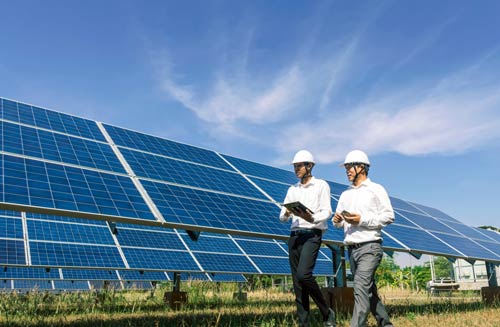Solar panels are the core part of a solar power generation system, and recently you can often see them installed on the roofs of houses in the city. Some people are blue, some are black, others are squares and triangles.
Therefore, in this article, we will explain the basics of Solar energy in Pakistan in an easy-to-understand manner, including an overview of solar panels, how they generate electricity, the amount of power generated, and the advantages and disadvantages of installing them. Having a basic knowledge of solar panels will help you decide if you should consider installing one in your home.
What is a solar panel
A solar panel is a panel-shaped facility for generating electricity from sunlight. They are called various names such as solar panels, solar cell plates, and solar cell modules. A wide variety of products are available, ranging from large-scale industrial products to small home-use products.
Solar panels, which are commonly seen in towns and suburbs, are products in which multiple small solar cells are collected and placed in an aluminum frame to form a large panel. When the light energy emitted by the sun hits the solar panel, electricity is generated.
Next, let’s check the configuration of the solar panel.
- cell
A cell is the most basic unit that makes up a solar panel. The size of one cell is about 10 cm square, and these cells are combined to form a solar panel.
- module
A module is made by arranging multiple cells and processing them into a plate. It is protected with resin or tempered glass so that it can be used outdoors.
- array
An array is made by arranging multiple modules and connecting them in parallel or in series. For residential use, it refers to the entire panel installed on the roof using a frame or the like on the roof.
In addition, there are three types of solar panels, depending on the material.
- Silicon
Silicon is the most common type of solar panel. Silicon-based solar panels are classified into four types: monocrystalline type, polycrystalline type, amorphous silicon, and HIT (heterojunction type). Of these, monocrystalline silicon is currently the mainstream for household equipment in Japan.
- Compound system
Solar panels made by mixing substances such as copper and indium are called compound systems. The compound system does not use silicon, so it can be mass-produced at low cost and resource saving, and it is characterized by little deterioration over time.
- Organic
Organic systems generate electricity through the photovoltaic effect using the pn junction of organic semiconductors. The advantage is that it is thin, lightweight, and can be bent freely, the solar panel itself can be colored, and the manufacturing cost is low. However, organic products have not been put into practical use and are not yet used for residential purposes.
How solar panels generate electricity
The solar cells that make up a solar panel are made of semiconductors such as silicon. When sunlight hits the semiconductor, it converts light energy into electrical energy according to the intensity of the sunlight. A typical silicon solar cell is made by bonding two types of semiconductors, an n-type semiconductor and a p-type semiconductor, which have different characteristics and are connected by a wire.
When sunlight hits a semiconductor, negative electrons gather in the n-type semiconductor and positive holes gather in the p-type semiconductor. This creates the same state as a dry battery, so if you connect a lead wire to the two electrodes, the electrons will move to the holes and electricity will flow.
The power generated at this time is called sunlife force, and this mechanism is called the photovoltaic effect. This is the principle of solar power generation with solar panels.
Recommended Article: NTPC declares commercial operation at Ettayapuram


